21st Marine Infantry Regiment
| 21e Régiment d'Infanterie de Marine | |
|---|---|
|
Regimental insigne | |
| Active | 1901–1940; 1940–1942; 1942–1955; 1955–present |
| Country | France |
| Branch | French Army |
| Type | Marine |
| Role | Infantry |
| Part of | 6th Light Armoured Brigade |
| Garrison/HQ | Fréjus, France |
| Nickname | Porpoises |
| Motto | Croche et tient |
| Colors | Red and blue |
| March | Marche du 21e RIMa |
| Anniversaries | Bazeilles |
| Battle honours |
Champagne 1915 Somme 1916 L'Aisne 1917 Reims 1918 Colmar 1944 Leimersheim 1945 Indochina 1945–1954 AFN 1952–1962 |
| Insignia | |
| Beret badge of the Troupes de Marine |
 |
| Abbreviation | 21e RIMa |
The 21st Marine Infantry Regiment (French: 21e Régiment d'Infanterie de Marine) (21e RIMa) is a unit of the French Army descended from the 2nd Marine Infantry Regiment (2e RIMa), It was also known as 2nd Colonial Infantry Regiment (2e RIC). It is one of the oldest and most decorated regiments of the French marines. Modern French marines are controlled by the army, not the navy as is common in the military of other nations. These units are often descended from colonial garrisons and overseas intervention forces rather than being shipborne soldiers.
Creation and designations
The 21e RIMa (or 21e RIC) has been the name of several formations throughout history. The 2nd Marine Infantry Regiment was created in 1899 to garrison overseas colonies and function as expeditionary troops. In 1901 the regiment became the 2nd Regiment of Colonial Infantry. This was part of a larger renaming process when the War Department took control of naval troops. On January 17, 1901 the 21st Regiment of Colonial Infantry (21e RIC) was established from a cadre provided by the 2e RIC. In July 1940 the regiment surrendered near the village of Parey-Saint-Césaire south of Nancy after taking enormous casualties.
On 1 September 1940 the 21e RIC was reformed by the Vichy Regime under the terms of the Second Armistice at Compiègne, but it was disbanded on 8 November 1942.
On 1 November 1944 the 4th Regiment of Senegalese Infantry was renamed the 21e RIC. It was again disbanded on 22 March 1955.
A new 21e RIC was created on 16 May 1955. This regiment became the 21st Marine Infantry Regiment (21e RIMa), again as part of a general renaming of colonial troops back to marines.
Moroccan Campaigns
Shortly after the regiment was founded in Paris as the 21e RIC on 17 January 1901 it served a brief stint in Morocco during the Agadir Crisis in the first regimental action appropriate to its designation as a colonial unit.
First World War
At the start of the war in 1914 the regiment was stationed in Paris and attached to the 5th Brigade of the 3rd Colonial Infantry Division. It was engaged primarily in Champagne, on the Somme and the Chemin des Dames and was cited in the Order of the Day four times. On 24 November 1918 the regiment received the Fourragère in the colors of the Médaille Militaire in recognition of its repeated citations.
Interwar period
During the 1920s and 1930s the 21e RIC was garrisoned with the 23e RIC in Paris. The regimental staff and the 2nd Battalion were quartered in Clignancourt with the 1st Battalion split between Ivry-sur-Seine and Saint-Denis and the 3rd Battalion at Bicêtre Hospital. The unit maintained a high tempo of training and also performed ceremonial duties required of troops stationed in Paris, participating in honor guards, parades and ceremonies. These included providing troops for the funerals of Marshalls Foch and Joffre.
During this time drafts of troops and officers were drawn off for overseas service with postings to the Levant, Madagascar, French West Africa, Algeria, Morocco, China, and the foreign military missions to Czechoslovakia and Poland. During some months as many as thirty officers left the regiment for colonial service.
World War II
Action at Villers-en-Argonne
In June 1940 the town of Villers-en-Argonne was the scene of fierce fighting and was virtually destroyed by bombing and fire. On 11 and 12 June the residents were evacuated from Villers as the front line was hard pressed. The men of the 2nd Battalion under Major Varrier were entrenched in an arc around Villers by 13 June with the rest of the regiment in a line to their east. Their mission was to prevent access to the Forest of Argonne, the road from Villers to Passavant-en-Argonne, and the gap south of Villers, a front three kilometers long. The battalion command post was at Villers. The Regiment as a whole was commanded by Colonel Cazeilles from Montdesir farm (west of Passavant) to the east of Villers.
The unit received reports that German motorized and armored troops were approaching. The 2nd Battalion set up their anti-tank guns (5x 25mm and 4x75mm) and machine guns in roadblocks around the town. The 6th RTS had been in contact with the enemy west of Villers in the direction of Braux-Saint-Remy and had retreated, reforming south of the 2nd Battalion positions in woods west of the village. On the morning of June 13 villages to the north, northwest and west of Villers were burning. At 1130 Major Varrier personally conducted two patrols on foot in front of Villers to the village of Ante and another by motorcycle to the Villers railway station (1 km west of the village) at 1330.
At 1430 two German tanks attempted to infiltrate on the left of the battalion in front of the 7th Company (Captain Allegrini) on the Ante road. Both tanks were knocked out by hits from 25mm guns between 300m and 200m from the company's position. A wounded German was captured and his papers passed to the regimental command post. The 1st Battalion, 11th Infantry Regiment of the 35th Infantry Division retreated, passing Villers on its way.
During the evening the Germans advanced to within 2.5 km. A company, commanded by Captain Marchenoir, of the 18th Battalion of the Light Infantry of Africa was made available to Major Varrier on the night of June 13 to 14 to strengthen the western side of Villers. Considering the situation on the spot, Varrier decided to position them facing north and personally positioned the company on the ground intending to avoid encirclement. On the morning of the 14th enemy movement across the front of the Battalion indicated that contact with enemy infantry was about to occur. Enemy aircraft, flying at low altitude, strafed the positions of the 2nd Battalion and the village of Villers during the morning.
Around 1330 the Germans begin to bombard the village and continued heavy artillery fire until 1500. Despite losses caused by the artillery, the 2nd Battalion remained steady under fire. The first shells were fired at the village, which within a few moments was heavily ablaze and was completely destroyed by the end of the bombardment. German infantry moved behind cover to about 800 m from the village and at 1500, the enemy, singing and shouting, probed the positions of the 2nd Battalion. The main effort occurred west of the village, falling on the 5th Company under Captain Charvet and the 6th Company under Captain Paganel. At the same time, with artillery support, the Germans pushed through the woods, on the flanks of the battalion, pressing on Captain Allegrini's 7th Company in an attempt to encircle its position. The 2nd Battalion received the attack steadily and their rifle, machine gun and grenade fire inflicted severe losses on the attacking infantry.
The Germans renewed their attacks for several hours, with close air support and artillery fire, until 1800. At points during these attacks, elements of the 5th and 6th Companies in the woods were engaged in very close range fights. During these attacks, Major Varrier requested artillery support. A battery of 155mm howitzers located 9 km behind the battalion were able to give the requested support. Despite calling in target and ranging information on a telephone and only having a 1:50,000 scale map, this fire was effective.
By 1900 the battle was over and the 2nd Battalion was in high spirits and ready to hold its ground. However Varrier was called to see Colonel Cazeilles at the regimental command post. The colonel expressed his satisfaction and congratulations, but communicated an order of withdrawal at 2130. Returning to his command post Major Varrier gave the order to withdraw. The withdrawal was made very difficult by continuing contact with the enemy and darkness and was finally accomplished by 0245 on the 15th. After the last units passed, Varrier ordered a Lieutenant of Engineers and four men to come with him and blow the bridge over the Aisne, the Pont aux Vendanges between Villers and Passavant. The bridge was destroyed at 0255.
Following the orders they had received, the 2nd Battalion moved 15 km southeast of Villers and reformed between Triaucourt and Charmontois L'abbé along a 4 km front. The 2nd Battalion and the regiment as a whole were disappointed to have given up the ground they had held in the face of serious attack but their continued movements south were necessary to protect and cover the retreat of other units.[1]
Destruction
By 21 June the Regiment, still alongside the 23e RIC, found itself fighting around Paray Saint-Césaire southwest of Nancy. After continuous fighting the exhausted regiment, without ammunition and overwhelmed by numbers, dispersed. Their battle flags were buried near Saint-Dié-des-Vosges and later recovered, moved to Toulon where they were again hidden during the occupation of Vichy France.
Vichy State
The unit was recreated on 1 September 1940 as the 21e Regiment of Colonial Infantry of the Armistice Army, but was disbanded after the German takeover of the Vichy areas on 8 November 1942.
Free French
On 1 November 1944 the 21e RIC was recreated from the 4th Regiment of Senegalese Riflemen in the 9th Colonial Infantry Division. It was attached to the First Army commanded by General de Lattre de Tassigny. Troops of North African descent were replaced by whites drawn from various sources, an episode referred to at the "bleaching of the 9th". These troops were initially stationed in Provence and won battle honors for the capturing the potash mines of Alsace, fighting in the Colmar Pocket, and the captures of Ensisheim, Leimersheim and Rastatt. The Regiment also earned the right to wear the Fourragère for its services in the Second World War.
Colonial Withdrawal
After the liberation of France and the German campaign the battalions of the regiment were sent to French Indochina during the First Indochina War. Between 1 November 1949 and until it was disbanded in 1955 the regiment was reconfigured as Marching Battalions (BM/21e RIC), meaning its battalions operated independently rather than under a regimental headquarters.
The regiment was reorganized 16 May 1955 as the 21e RIC. It was sent to serve in the Algerian War in 1956 and participated in the Suez Crisis. The regiment was tasked with the pacification of Kabylie until its withdrawal in 1962. During this time the Regiment was renamed again to the 21st Marine Infantry Regiment, 21e RIMa. After these campaigns in Indochina and Algeria it had two further citations in the Orders of the Day and received the right to wear the Overseas Operations Ribbons.
Modern Era
The regiment was stationed in Sissonne in the Aisne during 1963. It was assigned to the 8th Infantry Division until 1980. The French Army began to reorganize a this time and the regiment moved to Fréjus in 1980. The regiment was attached to the 31st Brigade which was the only mixed arms formation in the French military at the time, having two squadrons of AMX 10 RC with two companies mounted in Véhicule de l'Avant Blindé, an artillery battery, and rapid reaction, support, and headquarters companies. It further included a training company. The 21e RIC formed the 31st Brigade with the 2nd Foreign Infantry Regiment.
This brigage was disbanded and the troops were reformed into the 6th Light Armoured Brigade. The French museum of naval troops was constructed at the 21e RIMa base, Camp Le Cocq at Fréjus.
The regiment faces the future with modern equipment. The 21e RIMA is poised to be engaged in the Central European Theater and operated in Kosovo in 1999, and it can be projected overseas or perform public service missions in mainland France. It is also the guardian of the traditions of the Marines.
Foreign Missions
For the past 25 years the regiment and its battalions have been engaged all over the world:

- 1979: Chad
- 1980: Gabon
- 1981–83: Lebanon
- 1984: Operation Manta in Chad
- 1985: Gabon, Bangui
- 1986: New Caledonia, Central African Republic,Chad
- 1987: Chad and Central African Republic
- 1988: New Caledonia,Bangui
- 1989: Gabon,Guyana,Bangui
- 1990: Chad,Gabon, Operation Daguet
- 1991: Gulf War (Division Daguet), Chad, Zaire
- 1992: Rwanda, Gabon, Central African Republic
- 1993: Djibouti, Sarajevo (UNPROFOR), Chad, Gabon, Rwanda
- 1994: Ivory Coast
- 1995: Sarajevo, Former Yugoslavia
- 1996: Former Yugoslavia (IFOR), Central African Republic
- 1997: Central African Republic
- 1998: Chad
- 1999: Macedonia, Kosovo (K-For)
- 2000: Lebanon, Bosnia, Senegal
- 2001: Mitrovica, Kosovo, Senegal
- 2002: Kabul, Mazar-e-Sharif, Afghanistan, Ivory Coast
- 2003: Licorne in Ivory Coast
- 2005: Kosovo, Ivory Coast
- 2006: Ivory Coast, New Caledonia
- 2007: Guyana, Chad, Senegal
- 2008: Chad, Senegal, Kosovo
- 2010: Afghanistan as part of the Operational Mentoring Liaison Team) program.
- 2013: Mali as part of Operation Serval
Commanders
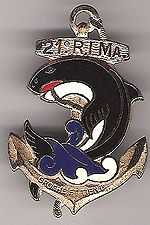
21st Marine Infantry Regiment
- 1980–1982: Colonel Accary [2]
- 1982–1984: Colonel Desmergers
- 1984–1986: Colonel Letourneur [3]
- 1986–1988: Colonel Rey
- 1988–1990: Colonel Sonic
- 1990–1992: Col. Pellegrini
- 1992–1994: Col. Philip Tracqui.
- 1994–1996: Colonel Bonningues
- 1996–1998: Colonel Boré
- 1998–2000: Colonel Loeuillet
- 2000–2002: Colonel Marill.
- 2002–2004: Colonel Castre
- 2004–2006: Colonel Duhau.
- 2006–2008: Colonel Collignon [4]
- 2008–2010: Colonel De MesMay
Decorations
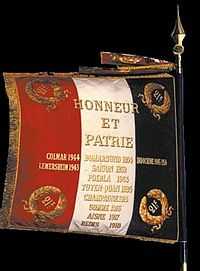
The Regimental banner is decorated with the Croix de Guerre 1914–1918 with four palms, the Croix de Guerre 1939-1945 with three palms and the Croix de Guerre of overseas theaters of operation with two palms and a star.
It bears, stitched in gold letters in its folds, the following inscriptions:[5]
- Citations:
- 4 citations in the order of the Army 1914–1918 (1915, 1917, 1918)
- 3 citations in the order of the Army 1939–1945 (1940, 1944, 1945)
- 2 citations in the order of the Army in Overseas Theaters of Operation Indochina (1948, 1950)
- 1 citations in the order of the brigade in Kosovo Kosovo (1999)
The regiment's "porpoises" have the right to wear the Fourragère in the colors of the Médaille Militaire ribbon received on 24 November 1918, with olive-colored ribbons of the Croix de Guerre from 1914 to 1918 and from 1939 to 1945 (received on 18 September 1946), and the Fourragère in the colors of the ribbon of the Croix de guerre des théâtres d'opérations extérieures (received 12 July 1955).
Insignia
-

Badge du 21e RIC -
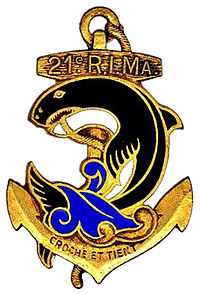
Badge du 21e RIMa -
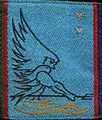
Badge the 31e Brigade.
-
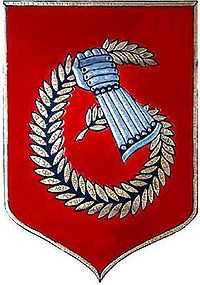
Badge the 6th Light Armoured Brigade.
-
.jpg)
Regimental badge of the 21st Marine Infantry Regiment during Operation Heracles (Afghanistan).
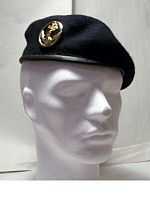
Traditions
The anniversary of French Marine Troops is celebrated on the occasion of the anniversary of the Battle of Bazeilles, which was abandoned and recaptured four times between 31 August and 1 September 1870.
The Marines (Propoises) and Marine Gunners (Bigors) have God himself as a patron saint. The war cry "And in the Name of God, long live the Colonials!" ends unit ceremonies that are part of the life of the Marine regiments. Its origin is a thanksgiving of Father Charles de Foucauld, a missionary, seeing colonial units come to his rescue on a day when he was in trouble with local tribesmen.
References
Notes
- ↑ Extract of articles in Le Petit Journal de Sainte Menehould
- ↑ First commanding officer of the 21st RIMa in Fréjus, Col. Accary is now a brigadier general and first deputy mayor of Frejus.
- ↑ saluted with his left hand because of a disability with his right hand.
- ↑ Ceased his functions in 2008 for the post of liaison officer at the African Center for Strategic Studies in Washington, United States.
- ↑ Decision 12350/SGA/DPMA/SHD/DAT 14 September 2007 relating to registration of names of battles on flags banners and military units of the Army, the military health service and fuel service armed forces of the Official Gazette, Number 27, November 9, 2007.
Sources and bibliography
| Wikimedia Commons has media related to Infanterie de marine. |
- Erwan Bergot, La coloniale du Rif au Tchad 1925–1980, imprimé en France : décembre 1982, n° d'éditeur 7576, n° d'imprimeur 31129, sur les presses de l'imprimerie Hérissey.